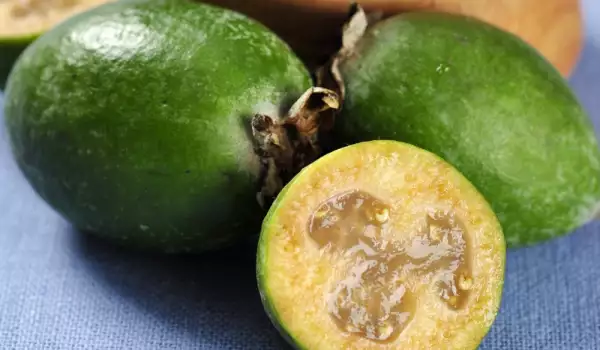Feijoa, Acea Berg, called iodine tree, or subtropical evergreen tree, is a fruit tree that is grown not only for its delicious fruits, but also because of its ornamental value. Feijoa belongs to the myrtle family. Comes from Colombia, northern Argentina, southern Brazil and Uruguay.
It is found in subtropical parts of the Caucasus, the Crimea, Azerbaijan and Krasnodar region. The colors of feijoa have a beautiful crimson color. The tree blooms in May-June, when it reaches 4-5 years of age.
Ripe fruits are dark green with a reddish tinge, and are soft to the touch. Their flavor is likened to strawberries and pineapple. Fruits of feijoa are elongated or oval-shaped, with a diameter of 1.5 - 2.5" (4-6 cm) and a length of 2 - 4" (5-10 cm). The average weight per fruit is from 0.88 oz (25g) to 1.76 oz (50 g).
History of feijoa
Feijoa gets its name from its discoverer - Director of the Brazilian Museum of Natural History Joanie de Silva Feijoo. As a cultural plant, feijoa has been known since 1890 when it first appeared in France. In 1900, it was brought to Sukhumi and Yalta, and in 1901 - California. The plant quickly spread in the Mediterranean.
Composition of feijoa

Feijoa is coincidentally called the iodine tree. The fruits of the tree are extremely rich in iodine and pectin. They also contain large amounts of vitamin C, which is vital for maintaining the required elasticity of your organs.
Unique is the ability of feijoa to accumulate in large amounts, its fruit helps the human body easily absorb the water-soluble compounds of iodine. 1 g of fresh feijoa fruit contains 10 mg iodine. Fruits contain 3.5% malic acid, 12.5% sugars, phenolic compounds and others. The essential oil in feijoa consists of 93 specific substances.
Growing feijoa
As a cultural plant species, Feijoa sellowiana is used. The tree reaches a height of 12 ft (4 m). The leaves are oval-elliptic, thick and shiny, silver-gray at the bottom and on top - green. The colors are very beautiful and the cup is composed of 4 petals. Numerous long stamens surround the crimson fleshy stalk of the pistil.
Flowering lasts approximately two months - from May-June-July. One tree produces about 66 lb (30 kg) of fruit and when grown under ambient conditions - only 4-7 lb (2-3 kg). The fruit is picked unripe and ripens very well in cool, dark places. When ripe, the fruits acquire different decorations, depending on variety and species - purple, yellow, red and others.
Feijoa is very fond of light, being a hydrophilic and thermophilic culture. Can be grown in poor stony soils and even sandy and rich soils. Responds very well to fertilization. During the hot summer months, these require irrigation. Feijoa is not attacked by many pests and diseases. Waterlogging the soil causes the conditions for development of fungal diseases.
Reproduction of feijoa is done by cuttings, seeds, and tapping shoots. The seeds are ready for planting 5-6 days after their separation from the flesh. They must be sown in February in a moistened mixture of soil, sand and peat in a 1:1:1 ratio of depth 0.5 cm, the seed can grow in 10-something days. When 3-5 leaves are formed, the plants are placed in separate dishes.

Feijoa gives growth in different directions, and flowers and fruits are formed on the growth of the current year, which requires pinching the shoots when they have a length of 8" (20 cm). This gives the plants a more compact structure and less height.
Culinary uses of Feijoa
The ripeness of feijoa can not be determined by the color of the fruit – whether ripe, or green, it will still be bright green. If the fruit is browning, do not eat it – it is probably off. Fruits of feijoa can be used for both fresh consumption and for making sauces, jellies, various drinks, sauces and glazes.
The fresh fruit is cut crosswise and fragrant and delicious fruit’s flesh is scraped with a teaspoon. Feijoa can be consumed in full, but not everyone does it, because skin is acidic and hard, and that would not appeal to every taste.
Benefits of feijoa
Because of its high iodine content, feijoa is an indispensable product for people with thyroid problems. Regular consumption of feijoa makes combating atherosclerosis successful. Higher amounts of vitamin C in the fruit help to keep organ walls in good condition. Feijoa is useful for hypertensive patients and those who suffer from cardiovascular diseases.








